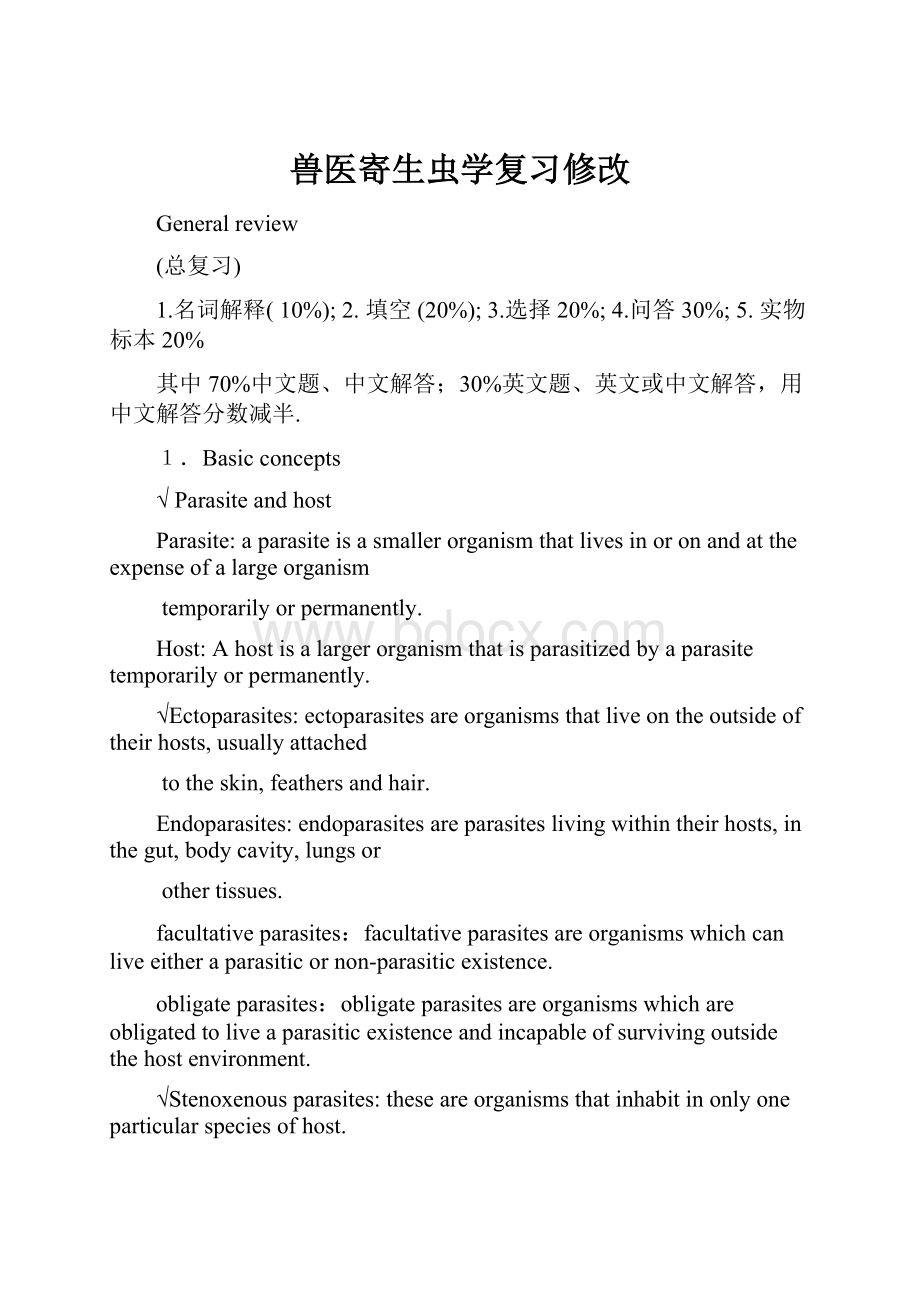兽医寄生虫学复习修改.docx
《兽医寄生虫学复习修改.docx》由会员分享,可在线阅读,更多相关《兽医寄生虫学复习修改.docx(26页珍藏版)》请在冰豆网上搜索。

兽医寄生虫学复习修改
Generalreview
(总复习)
1.名词解释(10%);2. 填空(20%);3.选择20%;4.问答30%;5. 实物标本20%
其中70%中文题、中文解答;30%英文题、英文或中文解答,用中文解答分数减半.
1.Basicconcepts
√Parasiteandhost
Parasite:
aparasiteisasmallerorganismthatlivesinoronandattheexpenseofalargeorganism
temporarilyorpermanently.
Host:
Ahostisalargerorganismthatisparasitizedbyaparasitetemporarilyorpermanently.
√Ectoparasites:
ectoparasitesareorganismsthatliveontheoutsideoftheirhosts,usuallyattached
totheskin,feathersandhair.
Endoparasites:
endoparasitesareparasiteslivingwithintheirhosts,inthegut,bodycavity,lungsor
othertissues.
facultativeparasites:
facultativeparasitesareorganismswhichcanliveeitheraparasiticornon-parasiticexistence.
obligateparasites:
obligateparasitesareorganismswhichareobligatedtoliveaparasiticexistenceandincapableofsurvivingoutsidethehostenvironment.
√Stenoxenousparasites:
theseareorganismsthatinhabitinonlyoneparticularspeciesofhost.
Polyxenousparasites:
theseareparasitesthatcaninfectmorethanonespeciesofhost.
√Permanentparasites:
theseareparasiteswhoseeverylifecyclestageisdependentonthehosts,andwhoselifewillterminateifbeingseparatedfromthehosts.
Temporaryparasites:
theseareorganismsthatliveonthehostsforonlyaveryshortperiodoftimeintheirlifecycle.
Soil-borneparasites:
biologicalparasites:
opportunisticpathogenicparasites:
theseareparasitiesthatdonotcauseanydamagetothehostundernormalcircustancesbutwillbecomepathogenicwhentheimmuefuctionofthehostsisattackedorcompromised.
√Intermediatehosts:
intermediatehostsarethehostsinwhichthelarvalstagesorasexualstagesofparasitedevelopandinhabitin.Someparasitesmayneedmorethanoneintermediatehosts.
√Finalhosts:
finalhostsareorganismsinwhichtheadultsorsexualstagesdevelopandparasitize.
Paratenicortransporthosts
Reservoirhosts:
reservoirhostsareorganismsinwhichaparasitethatispathogenictosomeotherspecieslivesandmultiplieswithoutdoingseriousdamagetotheseorganisms.
Carryinghosts(带虫宿主)
√Vector:
vectorisatransmitterofpathogenicparasitesfromhosttohost.
1hosttick:
one-hosttickwheretheentireparasiticdevelopmentfromlarvaetoadulttakesplaceononehost.
2hosttick:
two-hosttickswherelarvaeandnymphsoccourononehostandtheadultsontheanother.
3hosttick:
three-hosttickswhereeachstageofdevelopmenttakesplaceondifferenthosts.
infectivestage:
prepatentperiod:
2、TaxonomyandNomenclatureofParasites
Majortaxa(分类阶元)
Kingdom(界),Phylum(门),Class(纲),Order(目),Family(科),Genus(属),species(种)
Binomialnomenclature(双名制命名法)genusname+speciesname
eg.Haemonchuscontortus(捻转血矛线虫)
3、ClassificationofParasites
Parasitescanberoughlydividedintothreecategories:
helminth(蠕虫),protozoa(原虫)andarthropod(节肢动物)
Helminthes(蠕虫)includetrematodes(吸虫),cestodes(绦虫),nematodes(线虫)andacanthocephalids(棘头虫)
4、ClassificationofNematodes(线虫的分类)
PhylumNemathelminthes(线形动物门)
尾感器纲(Phasmidia):
杆形目(Rhabditata),蛔目(Ascaridata),尖尾目(Oxyurata),圆线目(Strongylata),旋尾目(Spirurata),丝虫目(Filariata),驼形目(Camallanata)
无尾感器纲(Aphasmidia):
毛尾目(Trichurata),膨结目(Dioctophymata)
5、ClassificationofTrematodes(吸虫的分类)
Platyhelminthes扁形动物门
Digenea(复殖目)
Fasciolidae(片形科)Paramphistomatidae(同盘科)Dicrocoeliidae(双腔科)
Schistosomatidae(分体科)Opisthorchiidae(后睾科)Prosthogonimidae(前殖科)
Echinostomatidae(棘口科)Notocotylidae(背孔科)
6、ClassificationofCestodes(绦虫的分类)
Platyhelminthes扁形动物门
Cestoidea绦虫纲
Pseudophyllidea假叶目
Cyclophyllidea圆叶目
Taeniidae(带科),Dilepididae(双壳科)Anoplocephalidae(裸头科),
Davaineidae(戴文科),Hymenolepididae(膜壳科)
7、ClassificationofProtozoa原虫的分类
(1).PhylumApicomplex(Sporozoa)顶复门(孢子虫)
OrderEucoccidia(“Coccidia”)(真球虫目)
OrderHaemosporida(血孢子虫目)
(2).PhylumSarcomastigophora(肉足鞭毛门)
SubphylumSarcodina(肉足虫亚门)(“Amoeba”)
SubphylumMastigophora(鞭毛虫亚门)
(3).PhylumCiliophora(“Ciliates”)(纤毛虫门)
8、ClassificationofArthopodes(节肢动物的分类)
Arthropoda(节肢动物门)
Insecta(昆虫纲) Flies,liceandfleas(双翅目昆虫、虱及蚤)
Arachnida(蛛形纲) Ticksandmites(蜱及蟎)
9、MorphologyofTrematodes
CharacteristicstructuresofDigeneticTrematodeare1or2suckers.
Theoralsuckerattheanteriorendsurroundsthemouth.
Theventralsuckerisontheventralsurface.
10、TheLifeCycleofDigeneticTrematodes
Needsonetotwointermediatehosts
Thefirstone:
snails(螺);
Thesecondone:
fishorarthropods(鱼或节肢动物)
StagesofLifeCycle(生活史各期)
卵(egg),毛蚴(miracidium),胞蚴(sporocyst),雷蚴(redia),尾蚴(cercaria),囊蚴(metacercaria)成虫(adult)
11、TheBasicLifeCycleofCestodes
involvelarvaldevelopmentin1or2intermediatehosts.
MorphologyofCestodes(绦虫的形态)
Tapewormsconsistof3regions:
a.Scolex(头节),b.Neck(颈节),c.Strobila(链体)
•immatureproglottids(幼节)
•matureproglottids(成节)
•gravidproglottids(孕节)
12、CharacteristicsofNematoda
Bodyisnon-segmented,elongate,andcircularincross-section(i.e.thename"roundworm").
Digestivetractiscomplete,includingmouth(口), pharynx(咽),esophagus(食道),intestine(肠管)andanus(肛门)
Malesystemisasingletubule(单管型),thefemalereproductiveorgansaredoubled(双管型)
13、BasicLifeCycleofNematodes
TherearefourmoltsinthecompletelifecycleandtheindividuallarvalstageisdesignatedL1(firststagelarvae),L2,L3,L4andL5.L5istheimmatureadult.
Typeoflifecycles
DirectLifeCycle(withoutanintermediatehost)(直接型)and
IndirectLifeCycle(withanintermediatehost)(间接型)
14、TheDevelopmentofProtozoa
Asexualreproduction(无性生殖)
Binaryfission(二分裂法);
MultiplefissionorSchizogony(复分裂或裂殖生殖);Budding(出芽生殖)
Sexualreproduction(有性生殖)
Conjugation(接合生殖)Gametogony(配子生殖)
15、MorphologyofTickandMite
Thebodyconsistsof2regions:
1.Capitulum(假头)2.Idiosoma(躯体).
Capitulumconsistsof:
Pedipalps(须肢),Chelicerae(螯肢)andHypostome(口下板)
16、CharacteristicsofInsecta
(1).3bodyparts-head,thorax,Abdomen
(2).Headcontainseyes,mouthpartsand1pairofantennae.
(3).thoraxpossesses3segments,eachwithapairoflegs.Wingsmayormaynotbepresent;extendfromlast2segmentsifpresent.
(4).Abdomencontainscopulatoryorgans
17、Developmentofthearthropods
Possess2typesofmetamorphosis(变态):
a.Incomplete:
egg——larva——nymph(若虫)——adult
b.Complete:
egg——larva——pupa(蛹)——adult
Developmentofticks,mitesandlicebelongtoincompletemetamorphosis,whereasbipteraninsectsandfleabelongtocompletemetamorphosis.
18、Keylinksintheprevalenceofparasiticdiseases
1)Sourceofinfection(感染源),
2)Routeofinfection(感染途径),
3)Susceptibleanimals(易感动物)
感染途径:
经口、经皮肤、接触感染、胎盘感染
19、PrevailingfeaturesandDistributionrule
Prevailingfeatures(流行特点):
Endemicity(地区性)Seasonality(季节性)Sporadicity(散发性)Naturalnidus(自然疫源性)
Distributionruleofparasites(寄生虫分布规律):
Regionaldistribution(地区性分布) Globaldistribution(全球性分布)
20、DiagnosisofParasiticDisease
1.临床诊断:
流行病学分析、临床症状观察、病理学检查
2.病原学诊断:
粪、尿、血、组织液的检查以及体表及皮屑的检查
3.辅助性诊断:
动物接种、诊断性治疗、X光及穿刺检查
4.免疫学诊断:
IHA,IFAT,ELISA等
5.基因诊断:
PCR-basedmethods
FAECALEXAMINATIONinclude:
directsmear,flotationandsedimentationmethod
21、Controlofparasiticdiseases
Thebasicprinciples:
Treatmentofthesourceofinfection(控制传染源)
Theblockadeoftherouteofinfection(切断传播途径)
Theprotectionofthesusceptibleanimals(保护易感动物)
22、寄生虫病的防控措施
驱虫:
1.治疗性驱虫,2.预防性驱虫(定期或长期给药)
环境卫生
1.粪便管理,2. 消灭中间宿主或传播媒介,3. 安全放牧
饲养卫生
1.保持饲草,饮水卫生;2.禁止以生鱼虾,蝌蚪以及贝类饲喂动物;3.勿用牛羊屠宰废弃物喂犬;4.注意个人卫生
免疫预防:
人工接种疫苗
生物防制:
利用天敌来消灭寄生虫
23、SchistosomiasisControl(example)
(血吸虫病的控制)
猪的寄生虫病
24、猪的人兽共患寄生虫主要有哪些?
请说出它们是怎样传播给人的?
吸虫类:
华枝睾吸虫、布氏姜片吸虫
绦虫类:
猪囊尾蚴
线虫类:
旋毛虫
原虫类:
刚第弓形虫
传播给人的途径方法:
华枝睾吸虫:
人由于吞食含有囊蚴的生鱼、虾或未煮熟的鱼或虾而遭受感染的。
布氏姜片吸虫:
人吃了附有囊蚴生菱角等而感染
猪囊尾蚴:
人吃了生的或未煮熟的囊尾蚴的猪肉后而感染
旋毛虫:
主要是嗜食生肉或肉品烹调不当,误食含有活的旋毛虫包囊所致。
刚第弓形虫:
人体感染是吃到肉、乳、蛋中的速殖子及污染蔬菜的卵囊和逗弄猫时吃到卵囊,经常接触动物的人,也可从感染动物的渗出液、排泄物等获得感染。
分类
名称
寄生部位
中间宿主
终末宿主
感染阶段
诊断阶段
防治药物
吸
虫
姜片吸虫
小肠
扁卷螺
人、猪
囊蚴
虫卵
吡喹酮、敌百虫、别丁
华枝睾吸虫
胆囊、胆管
第一、淡水螺
第二、鱼、虾
人、猪、狗
囊蚴
虫卵
吡喹酮、丙酸哌嗪、
丙硫苯咪唑
绦
虫
囊尾蚴
横纹肌、心、脑、眼、小肠(成虫)
猪、狗、猫
人
囊尾蚴
吡喹酮、丙硫苯咪唑
细颈囊尾蚴
肝脏浆膜、网膜、肠系膜
猪、牛、羊
犬、狼
吡喹酮、硫双二氯酚
棘球蚴
肝、肺
猪、牛、羊
犬
线
虫
旋毛虫
成虫:
小肠、幼虫:
横纹肌
人、猪、犬、猫、鼠
人、猪、犬、猫、鼠
丙硫咪唑、甲苯咪唑
颚口线虫
胃
剑水蚤
贮藏:
鱼、蛙
猪
感染性幼虫
胚卵
敌百虫、丙硫咪唑、伊维菌素
冠尾线虫
肾脏、输尿管
猪
感染性第3期幼虫
虫卵
后圆线虫
气管、支气管
蚯蚓
猪
感染性第3期幼虫
虫卵
食道口线虫
结肠
猪
感染性第3期幼虫
虫卵
毛首线虫
大肠(结肠)
猪
含1期幼虫虫卵
刚排出虫卵
丙硫咪唑、伊维菌素、
蛔虫
小肠
不需要
贮藏:
蚯蚓
猪
感染性虫卵
刚排出虫卵
左旋咪唑、丙硫咪唑、伊维菌素、多拉菌素
棘头虫
蛭形巨吻
小肠
蛴螬
猪、狗、猫
感染性棘头囊
粪便中含胚胎虫卵
左旋咪唑
原
虫
弓形虫
各种组织
人畜、野生动物
猫
磺胺类、乙胺嘧啶
球虫
肠上皮细胞
猪
磺胺药、
小袋纤毛虫
大肠
人、猪
包囊
呋喃唑酮、灭滴灵
住肉孢子虫
横纹肌、心肌
猪
人
包囊
外
寄
生
虫
疥螨
皮肤
猪
敌百虫、双甲咪、螨净、伊维菌素、多拉菌素
蠕形螨
毛囊、皮脂腺
猪
猪血虱
体表
猪
25、在散养条件下猪的常见寄生虫有哪些?
请分别说出它们的寄生部位、中间宿主或终末宿主、感染性阶段和诊断性阶段名称,防治猪的各类寄生虫常用的药物有哪些?
1.吸虫:
布氏姜片吸虫,华枝睾吸虫
2.绦虫:
猪囊尾蚴,细颈囊尾蚴,裂头蚴
3.线虫:
旋毛虫,猪蛔虫,食道口线虫,毛首线虫,类圆线虫,后圆线虫,有齿冠尾线虫,颚口线虫,猪圆线虫
4.棘头虫:
蛭形巨吻棘头虫
5.原虫:
刚第弓形虫,猪球虫,结肠小袋纤毛虫
6.外寄生虫:
猪疥螨,猪蠕形螨,猪血虱
26、在集约化饲养管理条件下猪的常见寄生虫有哪些?
他们是怎样感染的?
如何诊断和防治?
Ascarissuum(猪蛔虫)
Oesophagostomumsp.(食道口线虫)
Trichurissuis(猪毛首线虫)
Strongyloidesransomi(兰氏类圆线虫)
Toxoplasmagondii(刚第弓形虫)
Coccidia(Isosporasuis猪等孢球虫,Eimeriaspp.艾美耳球虫)
Balantidiumcoli(结肠小袋纤毛虫)
Sarcoptesscabieivar.suis(猪疥螨)
猪主要是吃了被这些寄生虫的虫卵、卵囊或包囊污染的饲料或饮水而感染的,猪疥螨是通过与病猪或用具的接触而感染的。
生前诊断是从流行病学分析,临床症状观察和病原检查三方面进行,死后诊断可结合剖检。
防治:
1)驱虫:
线虫和疥螨可用伊维菌素,弓形虫和球虫可用磺胺类,小袋纤毛虫可用灭滴灵;2)环境卫生;3)加强饲养管理
反刍兽寄生虫病
27、反刍兽的人兽共患寄生虫主要有哪些?
它们是怎样感染的?
如何诊断和防治?
吸虫:
日本血吸虫,肝片吸虫;绦虫:
牛囊尾蚴,棘球蚴;原虫:
隐孢子虫
反刍兽主要是吞食了被这些寄生虫虫卵、卵囊、囊蚴污染了的草、料和饮水,或是接触了被血吸虫尾蚴污染的疫水而感染的。
生前诊断是从流行病学分析、临床症状,病原学检查,免疫学及分子生物学检查,实验室检查等方面进行,棘球蚴的生前诊断比较困难。
死